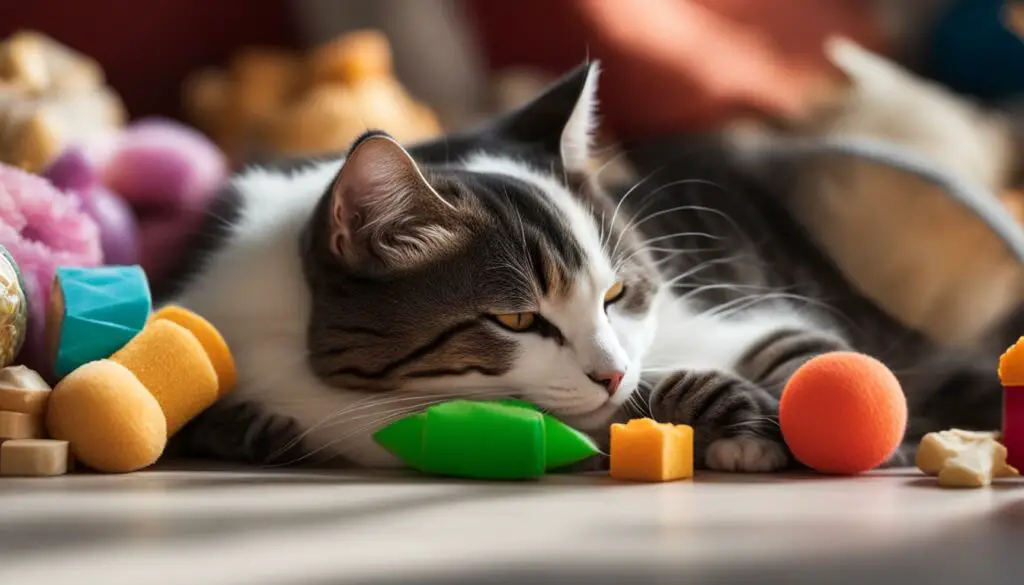As a pet parent, understanding feline emotions and behavior is essential for ensuring the well-being of your beloved cat. Unlike humans, cats can’t express their feelings through words, so it’s up to us to decipher their unique language.
In this comprehensive guide, I will walk you through the signs and behaviors that indicate a cat’s happiness. By recognizing these signals, you can strengthen the bond with your feline friend and create an environment that promotes their contentment and joy.
Takeaways>
Signs of a Happy Cat
A contented cat is a joy to be around. As a responsible pet parent, it’s important to recognize the signs that indicate your feline friend’s happiness. By understanding these signs, you can ensure that your cat’s needs are met and create a harmonious environment for them to thrive in.
There are several behaviors and body language cues that can indicate a happy cat. These signs include a raised tail, slow blinking, headbutting, positive relationships with other cats, kneading behavior, purring, trilling and chirping, playful behavior, healthy appetite, good grooming habits, and social behavior. When your cat displays these behaviors, it’s a clear indication that they are content and joyful.
It’s important to remember that each cat is unique, and their expressions of happiness may vary. While some cats may purr loudly when they’re happy, others may prefer to knead and cuddle. By observing your cat’s individual behavior and recognizing the signs of happiness that are specific to them, you can deepen your bond and ensure their overall well-being.
| Signs of a Happy Cat | Description |
|---|---|
| Raised Tail | A cat with a raised tail indicates confidence and contentment. |
| Slow Blinking | When a cat slow blinks at you, it’s a sign of trust and relaxation. |
| Headbutting | Headbutting is a display of affection and a sign that your cat feels safe and comfortable with you. |
| Positive Relationships with Other Cats | A happy cat will have friendly interactions with other cats in the household. |
| Kneading Behavior | Kneading is a sign of contentment and is often accompanied by purring. |
| Purring | A cat’s purring is a clear indication of happiness and relaxation. |
| Trilling and Chirping | These vocalizations are a sign of excitement and joy. |
| Playful Behavior | A happy cat will engage in playful activities, such as chasing toys or pouncing on objects. |
| Healthy Appetite | A cat with a good appetite is generally happy and content. |
| Good Grooming Habits | A well-groomed cat takes pride in their appearance and is often a sign of contentment. |
| Social Behavior | A happy cat will seek out social interaction with their human companions. |
By paying attention to these signs and behaviors, you can ensure that your cat is experiencing a state of happiness. Remember to provide them with a stimulating and safe environment, regular playtime, and plenty of love and attention. With your care and understanding, you can contribute to your cat’s happiness and enjoy a mutually fulfilling relationship.
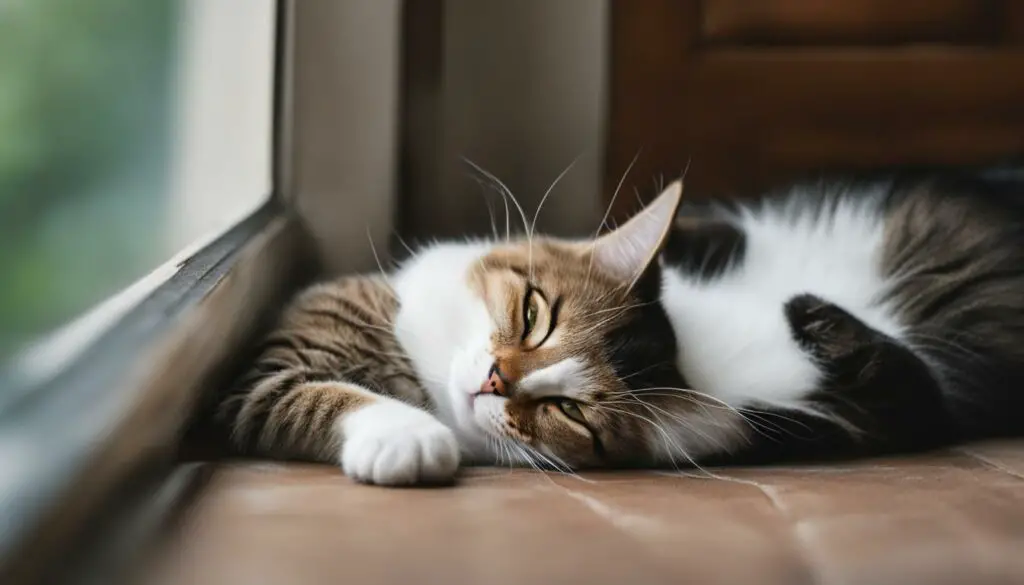
The Internet-Famous “Happy Cat”
When it comes to internet-famous cats, one name that often comes to mind is Grumpy Cat. Known for her perpetually grumpy expression, she quickly became a sensation online. However, not all internet-famous cats are known for their gruff demeanor. In fact, there are numerous feline stars who have captured our hearts with their infectious happiness and joy.
One such internet-famous “Happy Cat” is Nala. Nala is a lovable tabby cat who has gained millions of followers on social media. With her bright eyes and constant smile, she exudes a sense of pure happiness. Watching her videos and seeing her playful antics brings a sense of joy to cat lovers around the world.
But what makes a cat like Nala so happy? It’s essential to understand that each cat is unique and may express happiness in different ways. Some cats may be more vocal, while others may show their joy through playful behavior or affectionate gestures. As pet parents, it’s crucial to recognize and appreciate these individual differences and provide an environment that nurtures their happiness.
| Signs of a Happy Cat: | How to Promote Happiness in Your Cat: |
|---|---|
|
|
Remember, a cat’s happiness is not solely dependent on external factors. While providing a safe and stimulating environment is important, it’s equally crucial to address their emotional needs and nurture a strong bond. By understanding and responding to your cat’s cues, you can create a life filled with happiness and joy for both you and your feline friend.
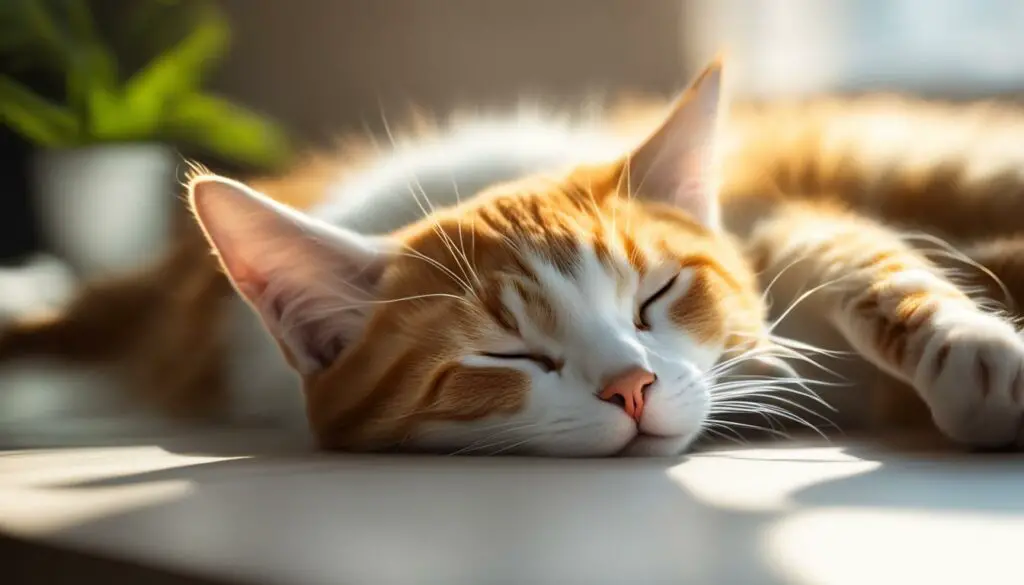
Happy Cat Month: Promoting Cat Welfare and Care
Happy Cat Month is an annual observance created by the CATalyst Council to raise awareness about the unique needs and well-being of our feline friends. This month-long celebration focuses on educating cat parents about providing the best care and nurturing a happy environment for their beloved pets.
During Happy Cat Month, cat parents are encouraged to invest in their furry companions’ happiness and welfare. One way to do this is by investing in engaging toys that provide mental stimulation and enrich their environment. Interactive toys can keep cats entertained and prevent boredom, satisfying their natural instincts to hunt and play.
Another important aspect of cat care during Happy Cat Month is scheduling extra play sessions. Regular playtime helps cats release energy, maintain a healthy weight, and strengthen the bond between pet and owner. It is an opportunity for cats to engage in physical activity, which is essential for their overall well-being.
| Ways to Celebrate Happy Cat Month: |
|---|
| Investing in engaging toys |
| Scheduling extra play sessions |
| Enriching the cat’s environment |
| Working on training |
| Ensuring routine healthcare check-ups |
Additionally, it’s essential to enrich the cat’s environment by providing scratching posts, vertical spaces, and hiding spots. Creating a cat-friendly home allows them to display their natural behaviors and provides them with a sense of security and comfort.
Happy Cat Month also serves as a reminder to schedule routine healthcare check-ups for our feline companions. Regular veterinary visits can help detect any underlying health issues, prevent diseases, and ensure that cats are receiving proper care. It’s an opportunity to address any concerns and provide preventive care to keep them healthy and happy.
By celebrating Happy Cat Month and paying attention to our cats’ welfare and care, we can strengthen the bond between pet and owner and ensure that our feline friends lead happy and fulfilling lives.
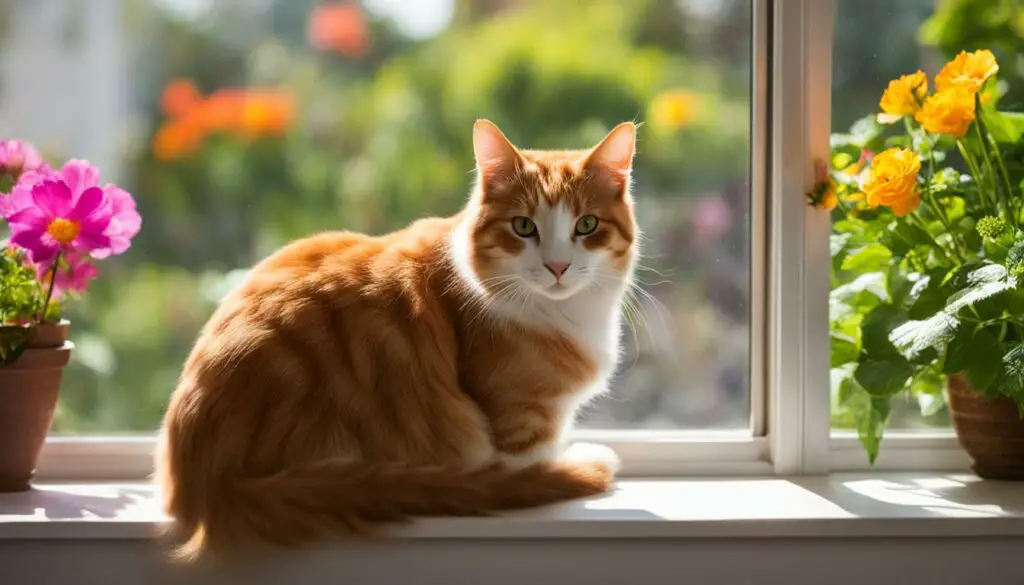
Happy Cat Month: Celebrating Feline Happiness and Well-being
Happy Cat Month is an annual observance that highlights the importance of cat welfare and care. During this special month, pet parents are encouraged to prioritize their cats’ happiness and well-being by investing in engaging toys, scheduling extra play sessions, enriching their environment, working on training, and ensuring routine healthcare check-ups. By taking these steps, we can contribute to our cats’ overall happiness and provide them with a fulfilling life.
Understanding Cat Body Language
Cat body language is a fascinating and important aspect of understanding our feline friends. By observing their tail position, eye shape, ear position, posture, and grooming habits, we can gain insights into their mood and emotions. Recognizing and interpreting these signals allows us to better meet their needs and ensure their happiness.
One key aspect of cat body language is tail position. A relaxed and gently swaying tail is a sign of a content and happy cat. On the other hand, a puffed-up or tucked tail may indicate fear or anxiety. Additionally, the position of their ears and eyes can provide valuable information about their emotional state. Upward-facing ears and soft eyes are indicators of a relaxed and content cat.
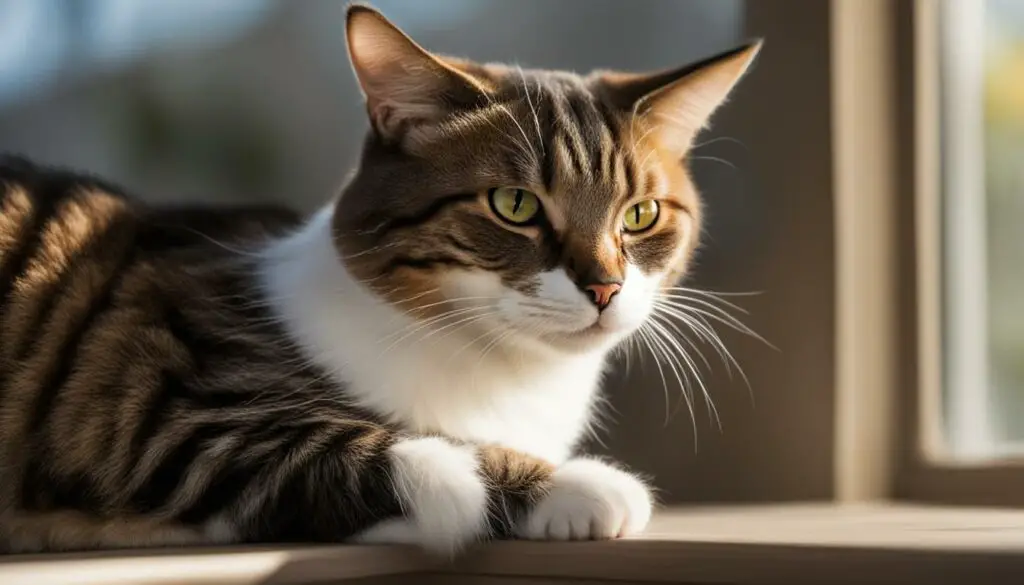
Understanding cat body language also involves observing their posture and grooming habits. A cat that crouches low to the ground with a tense body may be feeling defensive or threatened. Conversely, a cat that stretches out and exposes their belly is likely feeling comfortable and at ease. Grooming is another important behavior to pay attention to. Cats groom themselves when they feel safe and secure, so a cat that is regularly grooming is generally in a positive state of mind.
Interpreting cat body language is a valuable skill that can enhance our bond with our feline companions. By familiarizing ourselves with their subtle cues and responding appropriately, we can create a nurturing and supportive environment that promotes their well-being. Whether it’s a gently swaying tail, relaxed eyes, or a contented grooming session, understanding cat body language allows us to better understand and meet the needs of our beloved cats.
Creating a Happy Environment for Your Cat
Cats thrive in a happy and enriching environment that meets their physical and emotional needs. By providing a conducive living space, you can enhance your cat’s overall well-being and ensure their happiness. Here are some essential elements to consider:
1. Comfortable Living Space
Ensure that your cat has a cozy and safe space to call their own. Provide a comfortable bed or blanket, along with hiding spots such as cat caves or cardboard boxes. This gives them a sense of security and a place to retreat to when they need some alone time.
2. High-Quality Nutrition
Feeding your cat a balanced and nutritious diet is crucial for their health and happiness. Consult with your veterinarian to determine the appropriate food for your cat’s specific needs. Ensure they have access to fresh water at all times.
3. Regular Play Sessions
Cats are natural hunters, and regular play sessions allow them to fulfill their instinctual needs. Use interactive toys that simulate prey, such as feather wands or laser pointers, to engage your cat in active play. This helps them expend energy and prevents boredom.
4. Interactive Toys and Vertical Spaces
Provide your cat with a variety of toys that stimulate their senses and encourage mental stimulation. Puzzle toys, treat dispensers, and scratching posts can keep them mentally engaged and physically active. Additionally, having vertical spaces like cat trees or shelves allows them to climb and explore their surroundings.
5. Opportunities for Social Interaction
Cats are social animals and enjoy the company of their human companions. Engage in regular interactive play sessions, provide affection and attention, and create a positive and comfortable social environment. However, it’s important to respect your cat’s boundaries and allow them to initiate interactions on their terms.
6. Environmental Enrichment
Enrich your cat’s environment by introducing new experiences and stimuli. This can include puzzle feeders, rotating toys, and even creating a window perch where they can observe the outside world. These enriching activities prevent boredom and promote a happy and fulfilled cat.
Remember, every cat is unique, so it’s essential to observe and understand your cat’s individual preferences and needs. By creating a happy environment that addresses their physical and emotional well-being, you can contribute to your cat’s happiness and ensure a joyful and fulfilling life.
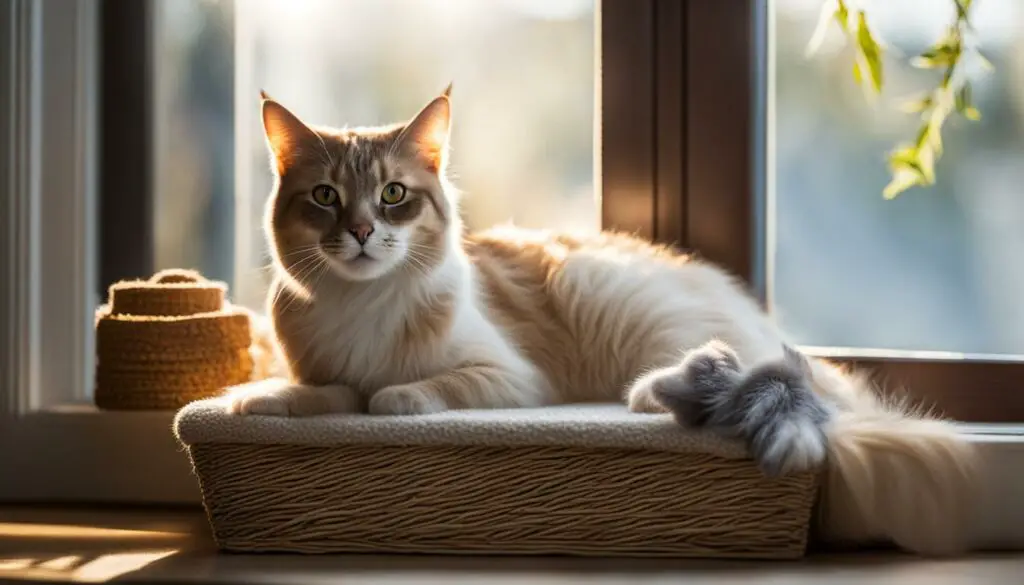
Promoting Physical and Emotional Health
When it comes to ensuring your cat’s happiness, promoting their physical and emotional health is paramount. By taking proactive measures to address their well-being, you can contribute to a content and thriving feline companion.
Regular veterinary check-ups play a crucial role in maintaining your cat’s physical health. These visits allow for early detection of any potential health issues and provide an opportunity to address any concerns you may have. Additionally, providing your cat with a balanced and nutritious diet tailored to their specific needs is essential for their overall well-being.
Ensuring your cat’s emotional health is equally important. Mental stimulation through interactive toys, puzzle feeders, and playtime can help keep their minds sharp and engaged. It’s also vital to provide them with a safe and comfortable environment where they can feel secure and relaxed. Creating a routine with consistent feeding and play times can help reduce stress and anxiety, contributing to their emotional well-being.
| Ways to Promote Physical and Emotional Health | Benefits |
|---|---|
| Regular veterinary check-ups | Early detection of health issues |
| High-quality nutrition | Overall well-being and vitality |
| Mental stimulation through interactive toys and play | Sharpness of mind and engagement |
| Creating a safe and comfortable environment | Reduced stress and anxiety levels |
| Establishing a routine | Emotional stability and well-being |
By prioritizing both the physical and emotional aspects of your cat’s health, you can contribute to their overall happiness and provide them with a fulfilling and joyful life.
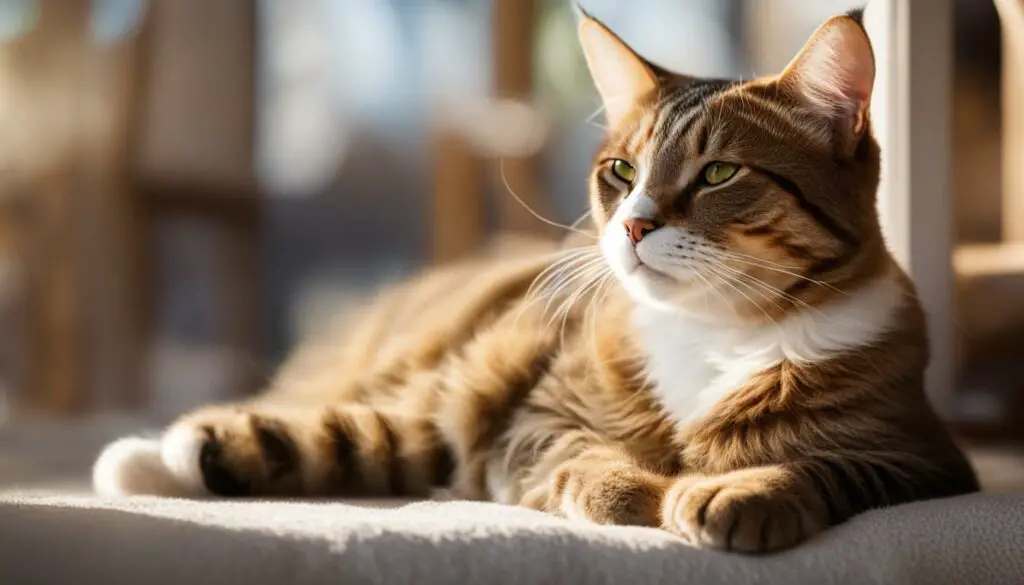
Promoting a Healthy Lifestyle
“A healthy cat is a happy cat. By ensuring regular veterinary check-ups, providing a nutritious diet, and engaging in mental stimulation, we can promote their physical and emotional well-being.” – Dr. Emily Thompson, Veterinarian
Bonding with Your Cat
Building a strong bond with your cat is essential for their happiness. As a cat parent, forming a deep connection with your feline friend not only brings joy to their lives but also enhances your own well-being. Strengthening the bond with your cat requires patience, understanding, and consistent effort. Here are some ways to foster a loving and harmonious relationship with your furry companion:
1. Spend Quality Time Together
Make it a priority to spend dedicated quality time with your cat each day. Set aside specific periods for interactive play sessions, grooming, or simply lounging together. Engaging in activities that your cat enjoys not only provides mental and physical stimulation but also strengthens the emotional bond between you.
2. Show Affection and Attention
Cats thrive on affectionate gestures and attention. Gently petting, stroking, or brushing your cat’s fur can create feelings of comfort and security. Pay attention to their body language and respect their boundaries, allowing them to initiate and guide the level of physical contact they are comfortable with.
3. Create a Sense of Security and Trust
Cats feel most relaxed when they have a safe and secure environment. Create a consistent routine and provide them with a dedicated space where they can retreat and feel at ease. By offering a predictable and stable environment, you can build trust with your cat and help them feel secure in your presence.
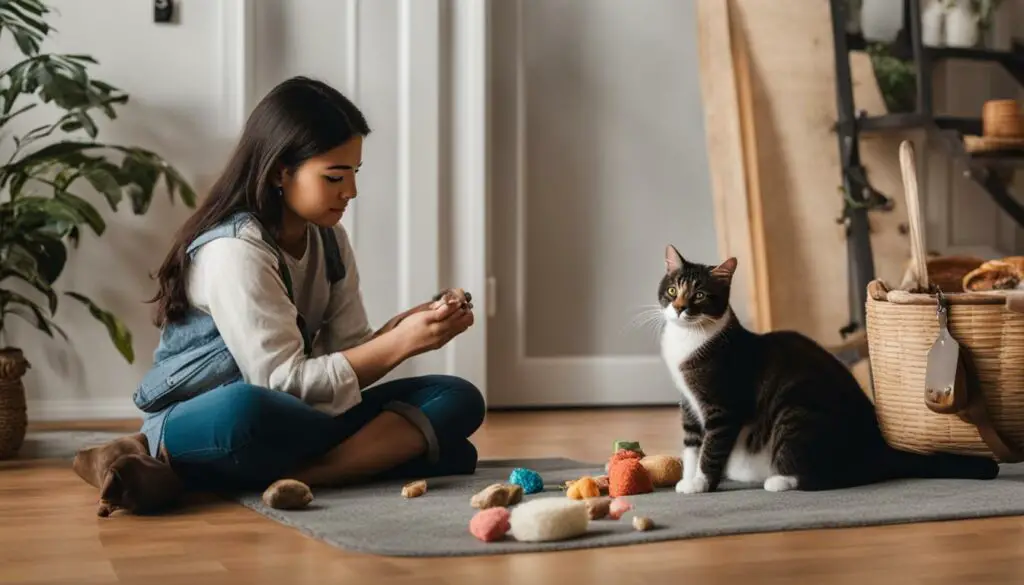
4. Engage in Interactive Play
Playtime is not just about fun; it also promotes bonding and relieves stress for both you and your cat. Use interactive toys, such as feather wands or laser pointers, to engage your cat in active play. Regular play sessions can strengthen your bond, provide mental stimulation, and ensure a healthy outlet for your cat’s natural hunting instincts.
5. Respect Your Cat’s Individuality
Each cat has their own unique personality and preferences. Respect and appreciate their individuality by observing their likes, dislikes, and communication styles. Understanding and responding to your cat’s needs and preferences will foster a deeper connection and demonstrate your commitment to their well-being.
By following these tips and investing time and effort into bonding with your cat, you can create a strong and loving relationship that brings happiness and fulfillment to both of you.
Recognizing Signs of Discomfort
As pet parents, it’s important for us to be attuned to our cat’s needs and well-being. While we may recognize signs of happiness in our feline friends, it’s equally crucial to be able to identify signs of discomfort, stress, or anxiety. By recognizing these signs early on, we can take the necessary steps to ensure our cat’s happiness and address any underlying issues that may be causing them distress.
Here are some common signs that may indicate your cat is experiencing discomfort:
- Changes in appetite: A decrease or increase in their food intake may be a sign that something is amiss.
- Altered litter box habits: If your cat suddenly starts urinating or defecating outside of their litter box, it could be a sign of underlying stress or discomfort.
- Excessive grooming: Cats are known for their grooming habits, but excessive grooming, leading to hair loss or skin irritation, may indicate anxiety or discomfort.
- Aggression: Uncharacteristic aggression towards humans or other pets can be a sign that your cat is feeling stressed or threatened.
- Hiding or avoidance behaviors: If your cat suddenly becomes more withdrawn or avoids certain areas or interactions, it may be a sign of discomfort.
If you notice any of these signs in your cat, it’s important to consult with your veterinarian. They can help determine the underlying cause of your cat’s discomfort and recommend appropriate solutions or treatments. Remember, each cat is unique, and what may cause stress or anxiety in one cat may not affect another. By being attentive and responsive to our cat’s needs, we can help ensure their happiness and well-being.
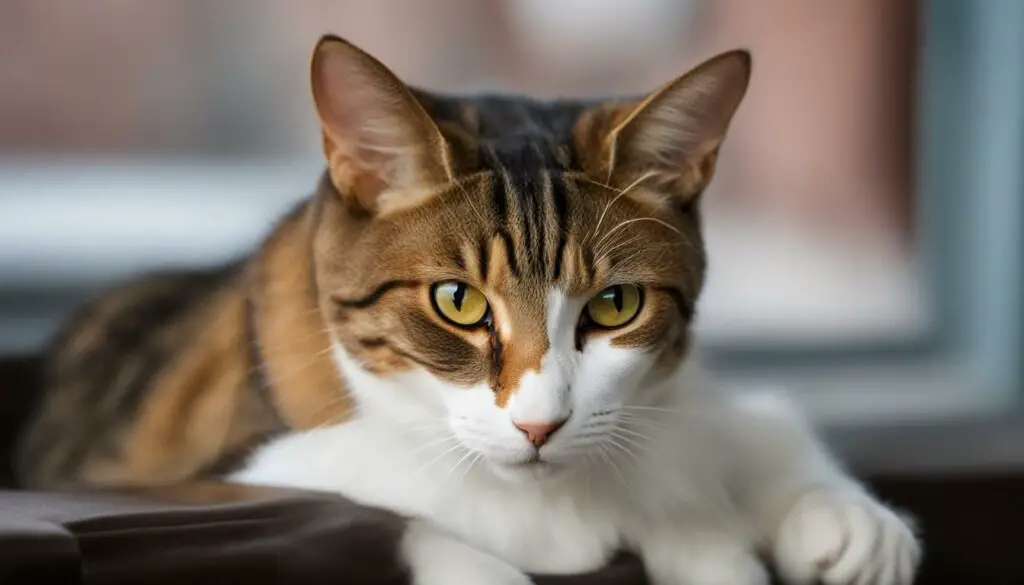
Table: Common Signs of Cat Discomfort
| Signs of Discomfort | Possible Causes |
|---|---|
| Changes in appetite | Pain, illness, stress |
| Altered litter box habits | Urinary tract issues, stress, anxiety |
| Excessive grooming | Stress, anxiety, skin irritation |
| Aggression | Fear, anxiety, territorial behavior |
| Hiding or avoidance behaviors | Stress, fear, discomfort |
Cat Enrichment Activities
Providing your cat with enrichment activities is essential for their mental stimulation and overall well-being. Engaging in play and providing opportunities for exploration and problem-solving can contribute to their happiness and prevent boredom. Here are some cat enrichment ideas to keep your feline friend entertained and engaged:
1. Interactive Toys
Invest in interactive toys that stimulate your cat’s hunting instincts. Toys that dispense treats or have hidden compartments for them to discover can provide mental and physical stimulation. Puzzle toys that require your cat to solve a challenge to access a reward can help keep their minds sharp and engaged.
2. Scratching Posts and Climbing Structures
Provide your cat with a variety of scratching posts and climbing structures to satisfy their natural instincts. Cats love to stretch, climb, and scratch, so having appropriate outlets for these behaviors can prevent them from damaging furniture and promote healthy exercise.
3. Catnip and Pheromone Toys
Consider introducing catnip or pheromone-infused toys to your cat’s playtime. Catnip can have a stimulating and enjoyable effect on many cats, while pheromone toys can help create a calming and stress-free environment.
4. Environmental Enrichment
Make your cat’s environment more interesting by adding hiding spots, perches, and visual stimuli such as bird feeders outside windows. You can also rotate toys and play areas to keep things fresh and exciting for your feline companion.
5. Play and Bonding Time
Set aside dedicated playtime with your cat to strengthen the bond between you and provide mental stimulation. Use interactive toys, feathers, or laser pointers to engage your cat in active play sessions. This not only helps them physically but also creates a positive association with you.
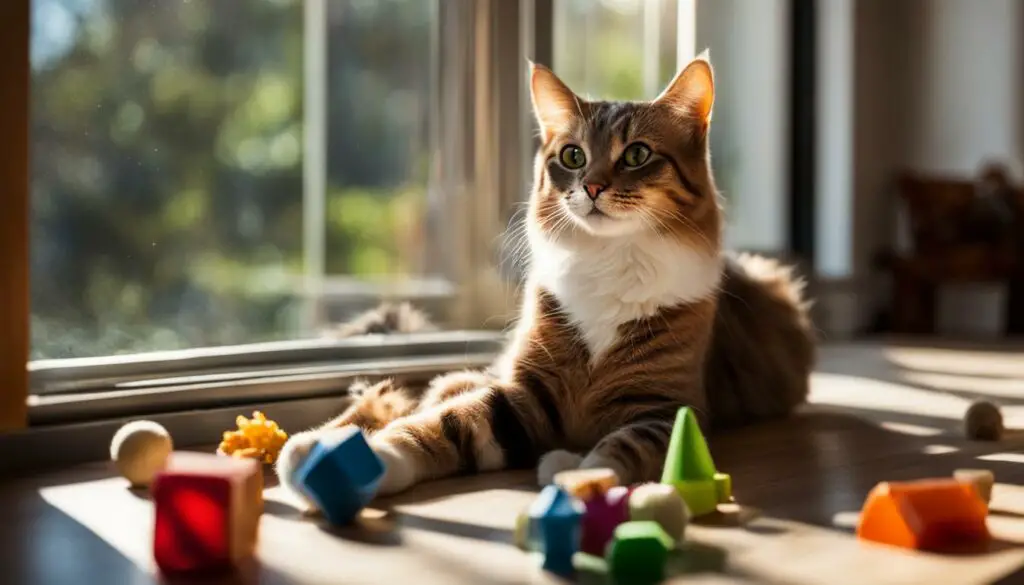
Remember, each cat is unique, so it may take some trial and error to find the activities and toys that your cat enjoys the most. Observe their behavior and preferences to ensure that the enrichment activities you provide are tailored to their individual needs. By incorporating these enrichment activities into your cat’s daily routine, you can help keep them happy, stimulated, and mentally sharp.
The Role of Social Interaction
Social interaction plays a crucial role in a cat’s overall happiness and well-being. Cats are social creatures by nature, and positive interactions with humans and other animals can greatly contribute to their emotional and mental health. By engaging in regular socialization activities, pet parents can foster a strong bond with their feline companions and create a positive social environment.
One important aspect of social interaction is providing ample opportunities for cat-human interaction. Spending quality time with your cat, such as petting, talking to them, and engaging in gentle play, can help strengthen the bond between you. It allows you to understand their individual preferences, communicate effectively, and create a sense of trust and security.
It’s essential to respect your cat’s boundaries and allow them to initiate interactions on their terms. Each cat has its own unique personality and comfort level with socializing. By observing their body language and cues, you can ensure that you are providing a positive and comfortable social environment for your cat.
Providing a Safe and Stress-Free Environment
Creating a safe and stress-free environment is crucial for your cat’s happiness and well-being. By taking steps to ensure their safety and minimize stressors, you can help them thrive and have a contented life. Here are some key factors to consider:
1. A Cat-Friendly Home
Make your home a cat-friendly haven by eliminating potential hazards. Secure loose cords, keep toxic plants out of reach, and store cleaning chemicals in a locked cabinet. Create designated areas for your cat’s litter box, food, and water bowls, and provide vertical spaces for climbing and scratching. Also, ensure that windows and balconies are safely enclosed to prevent falls.
2. Reduce Noise and Stress
Cats are sensitive to loud noises and excessive commotion. Minimize loud sounds by closing windows during thunderstorms or fireworks displays. Provide a quiet retreat for your cat where they can escape noise and feel secure. Additionally, establish a routine that offers stability and predictability, helping to reduce anxiety and provide a sense of security.
3. Comfortable and Safe Resting Areas
Provide your cat with cozy and comfortable resting areas where they can retreat and relax. This can be a soft bed, a warm blanket, or a cat tree with a comfortable perch. Make sure these areas are in quiet corners of the house, away from high-traffic areas, and free from disturbances.
4. Introduce Changes Gradually
Cats are creatures of habit and can become stressed by sudden changes in their environment. When making changes such as rearranging furniture or introducing new family members or pets, do so gradually. Allow your cat time to adjust and provide them with plenty of reassurance and positive experiences during the transition.
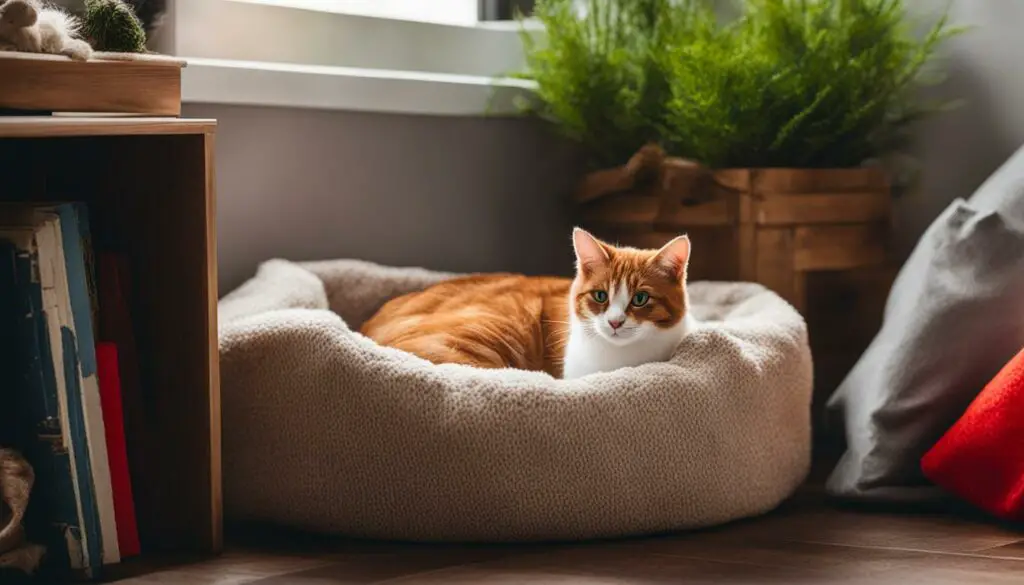
| Table: Common Hazards to Avoid | Tips for Prevention |
|---|---|
| Household chemicals | Store cleaning products in secure cabinets |
| Toxic plants | Research and remove plants that are toxic to cats |
| Open windows and balconies | Secure windows and balconies to prevent falls |
| Unprotected cords | Secure cords out of reach or use cord protectors |
| Small objects | Keep small objects that could be swallowed out of reach |
By implementing these measures, you can create a safe and stress-free environment that promotes your cat’s well-being. Remember to observe their behavior and adjust as needed to ensure their ongoing happiness and comfort.
Understanding the Cat-Human Relationship
The cat-human relationship is a unique bond that requires understanding, patience, and effective communication. Cats have their own ways of expressing their needs and emotions, and it’s important for pet parents to learn how to interpret their behavior and respond accordingly. By understanding the cat-human relationship, we can build a strong connection with our feline friends and ensure their happiness and well-being.
Cat communication is not verbal, but rather expressed through body language, vocalizations, and subtle cues. It’s crucial for pet parents to familiarize themselves with these forms of communication to better understand their cat’s needs and emotions. For example, a soft purr and relaxed body language often indicate contentment and happiness, while flattened ears and hissing may signal fear or aggression.
Recognizing and respecting the individuality of our cats is also key to fostering a healthy cat-human relationship. Each cat has its own preferences, boundaries, and unique personality traits. Some cats may enjoy being held and cuddled, while others may prefer independent playtime. By paying attention to their likes and dislikes, we can create an environment that makes them feel safe, secure, and loved.
Understanding Cat Needs
To establish a strong bond with our cats, it’s essential to meet their physical and emotional needs. Cats require mental stimulation, social interaction, and a safe and comfortable environment. Providing interactive toys, scratching posts, and vertical spaces satisfies their natural instincts and keeps them mentally and physically active. Regular play sessions and quality time spent together strengthen the bond and promote overall well-being.
Nurturing the cat-human relationship also involves addressing their emotional needs. Cats crave love, attention, and a sense of security. Creating a routine that offers stability and predictability helps them feel safe and reduces stress. Additionally, providing a designated space for relaxation and quiet time allows them to retreat and recharge when they need it. By understanding and fulfilling their needs, we can establish a deep and meaningful connection with our cats.
| Benefits of Understanding the Cat-Human Relationship |
|---|
| Stronger bond: By understanding our cat’s behavior and needs, we can strengthen the bond and create a deeper connection. |
| Improved well-being: Meeting our cat’s physical and emotional needs ensures their overall happiness and well-being. |
| Effective communication: Understanding cat communication allows us to respond appropriately and address their needs promptly. |
| Reduced stress: Providing a safe and comfortable environment reduces stress and promotes a harmonious relationship. |
| Enhanced quality of life: By nurturing the cat-human relationship, we contribute to our cat’s overall quality of life and happiness. |
The Role of Routine and Structure
Creating a routine and providing a structured environment is crucial for a cat’s well-being. Cats thrive on predictability and feel more secure when they know what to expect. By establishing consistent feeding, play, and sleep schedules, you can help your cat feel safe and comfortable. A structured routine provides a sense of stability and reduces stress and anxiety.
Table: Benefits of Routine and Structure in a Cat’s Life
| Benefits | Description |
|---|---|
| Reduced Stress | A structured routine helps cats feel more secure and less anxious, as they know what to expect from their daily lives. |
| Improved Behavior | Having a consistent routine can help minimize behavioral issues such as aggression, inappropriate urination, and excessive scratching. |
| Enhanced Bonding | When cats have a predictable routine, they develop a stronger bond with their owners, as they feel safe and cared for. |
| Physical Health | A structured routine ensures that cats receive regular meals, exercise, and sleep, promoting their overall physical well-being. |
| Mental Stimulation | A structured environment provides opportunities for cats to engage in play and other mentally stimulating activities, preventing boredom. |
By adhering to a routine, you establish a sense of stability and structure in your cat’s life. This promotes their overall well-being and helps them thrive mentally, physically, and emotionally. Remember to be consistent and patient as your cat adjusts to the new routine, and always monitor their behavior and adapt the schedule as needed to ensure their happiness and comfort.
The Importance of Emotional Well-being
When it comes to our feline companions, their emotional well-being plays a crucial role in their overall happiness and quality of life. Just like humans, cats experience a range of emotions, and it’s important for us as pet parents to understand and address their emotional needs.
One key aspect of promoting cat emotional well-being is providing mental stimulation. Cats are intelligent and curious animals, and they need activities that engage their minds and prevent boredom. Interactive toys, puzzle feeders, and scratching posts are excellent ways to keep your cat mentally stimulated and emotionally fulfilled.
Social interaction is another vital component of a cat’s emotional well-being. While cats may have a reputation for being independent, they still crave love and attention from their human companions. Regular play sessions, gentle petting, and talking to your cat can all help strengthen your bond and contribute to their happiness.
In addition to mental stimulation and social interaction, it’s important to create a safe and stress-free environment for your cat. Minimizing exposure to loud noises, providing hiding spots, and establishing a routine can all help reduce stress and anxiety. Cats thrive in a peaceful atmosphere, and by prioritizing their emotional well-being, you can create a sanctuary where they can relax and feel secure.
| Ways to Promote Cat Emotional Well-being: |
|---|
| Provide mental stimulation through interactive toys and puzzle feeders |
| Engage in regular play sessions and gentle petting to fulfill their social needs |
| Create a safe and stress-free environment by minimizing exposure to loud noises and establishing a routine |
By prioritizing your cat’s emotional well-being, you can ensure that they lead a happy and fulfilling life. Remember, every cat is unique, so it’s important to pay attention to their individual needs and preferences. With love, care, and attention, you can create a nurturing environment where your feline companion can thrive.
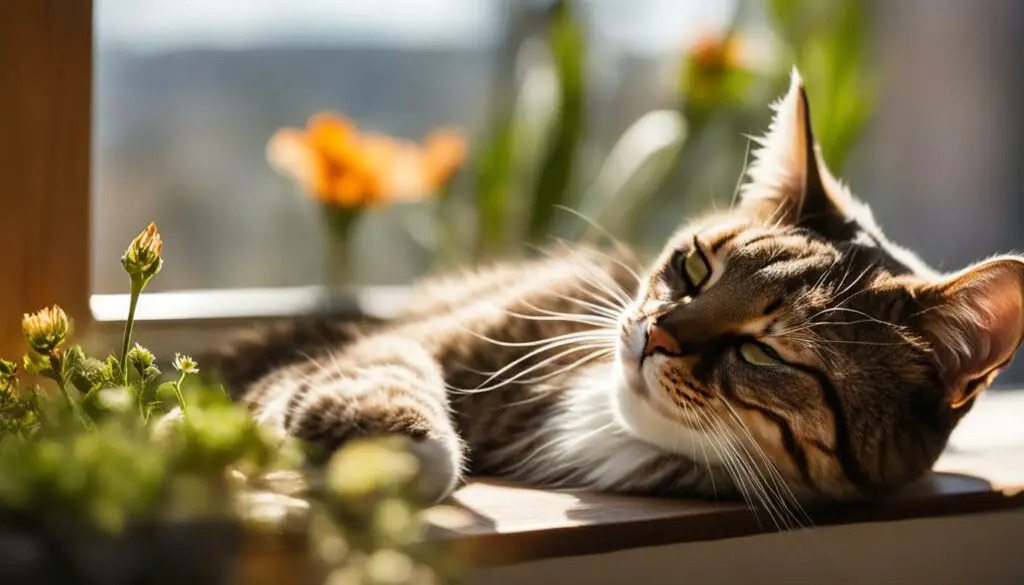
Conclusion
Understanding and recognizing the signs of a happy cat are crucial for pet parents. By observing their behavior and body language, providing a stimulating and safe environment, promoting their physical and emotional health, and nurturing the bond between you, you can ensure your cat’s happiness. Remember that each cat is unique, and their expressions of happiness may vary. Stay attentive, responsive, and dedicated to meeting your cat’s needs for a content and joyful feline companion.
By paying close attention to the subtle cues your cat gives you, you can gain valuable insights into their emotions. Look for signs like a raised tail, slow blinking, and headbutting to determine if your cat is content and happy. Creating a positive environment that includes interactive toys, vertical spaces, and hiding spots will engage their natural instincts and contribute to their well-being.
Promoting your cat’s physical and emotional health is essential for their overall happiness. Regular veterinary check-ups, a balanced diet, and mental stimulation will keep them healthy and content. Building a strong bond with your cat through quality time, affection, and respect will deepen your connection and enhance their happiness.
Remember, cats have their own unique personalities and ways of expressing happiness. Stay attuned to your cat’s individual needs and preferences, and provide a safe, stress-free environment that allows them to thrive. By prioritizing their happiness and well-being, you can enjoy a fulfilling and rewarding relationship with your feline companion.
FAQ
How do you know when a cat is happy?
Cats express happiness through various signs and behaviors. These include a raised tail, slow blinking, headbutting, positive relationships with other cats, kneading behavior, purring, trilling and chirping, playful behavior, healthy appetite, good grooming habits, and social behavior.
What is the “Happy Cat” phenomenon on the internet?
The “Happy Cat” phenomenon refers to the viral videos and images of cats displaying exuberant joy. While these videos showcase a cat’s excitement, it’s important to remember that not all cats express happiness in the same way. Each cat has a unique personality and may exhibit happiness in various degrees and ways.
What is Happy Cat Month?
Happy Cat Month is an annual observance created by the CATalyst Council. It encourages cat parents to learn more about their pet’s unique needs, health, and welfare. During this month, pet parents can celebrate by investing in engaging toys, scheduling extra play sessions, enriching the cat’s environment, working on training, and ensuring routine healthcare check-ups.
How can I understand my cat’s body language?
Cat body language is a vital tool for understanding their emotions. By observing their tail position, eye shape, ear position, posture, and grooming habits, you can gain insights into their mood. For example, a relaxed and gently swaying tail, soft eyes, and upward-facing ears indicate a content and happy cat.
How can I create a happy environment for my cat?
Creating a happy environment for your cat involves meeting their basic needs and providing opportunities for mental and physical stimulation. This includes offering a comfortable living space, high-quality nutrition, regular play sessions, interactive toys, vertical spaces, hiding spots, and opportunities for social interaction.
How can I promote my cat’s physical and emotional health?
A healthy cat is more likely to be a happy cat. Regular veterinary check-ups, proper nutrition, grooming, parasite control, and mental stimulation are crucial for maintaining your cat’s physical and emotional health. By addressing any underlying health issues and providing appropriate care, you can ensure that your cat is living a happy and fulfilling life.
How can I bond with my cat?
Building a strong bond with your cat is essential for their happiness. Spend quality time with your cat, engage in interactive play sessions, provide affection and attention, and create a sense of security and trust. By establishing a deep bond, you can foster a positive relationship and contribute to your cat’s overall happiness and well-being.
What are the signs of discomfort in a cat?
Changes in appetite, litter box habits, excessive grooming, aggression, hiding, or avoidance behaviors may indicate underlying issues such as stress or anxiety. By addressing these signs promptly and seeking veterinary care if needed, you can ensure your cat’s happiness and alleviate any potential discomfort they may be experiencing.
How can I provide enrichment activities for my cat?
Engaging your cat in enrichment activities is crucial for their happiness and well-being. Provide interactive toys, puzzle feeders, scratching posts, and opportunities for exploration. Encourage playtime and engage your cat in mentally stimulating activities. By stimulating their natural instincts and providing outlets for energy, you can enhance their happiness and overall quality of life.
Why is social interaction important for cats?
Cats are social creatures that benefit from positive interactions with humans and other animals. Regular social interaction, such as petting, talking, and gentle play, can contribute to their happiness. However, it’s essential to respect your cat’s boundaries and allow them to initiate interactions. By providing a positive and comfortable social environment, you can foster a happy and socially well-adjusted cat.
How can I create a safe and stress-free environment for my cat?
Creating a safe and stress-free environment is vital for your cat’s happiness. Ensure that your home is cat-friendly and free from potential hazards. Provide quiet spaces for relaxation, minimize exposure to loud noises or stressful situations, and establish a routine that offers stability and predictability. By reducing stress levels and creating a peaceful atmosphere, you can contribute to your cat’s happiness.
How can I understand my cat’s needs and communicate effectively?
The cat-human relationship is unique and requires understanding and effective communication. Learn to interpret your cat’s vocalizations, body language, and preferences to better respond to their needs. Recognize and respect their individuality and provide a nurturing and supportive environment. By building a strong and positive relationship, you can ensure your cat’s happiness and provide a fulfilling life for both of you.
Why is routine and structure important for cats?
Cats thrive on routine and structure. Establish consistent feeding, play, and sleep schedules to provide them with a sense of security and predictability. Avoid sudden changes or disruptions that can cause stress or anxiety. By providing a stable and structured environment, you can contribute to your cat’s happiness and help them feel safe and comfortable.
What is the importance of emotional well-being for cats?
Emotional well-being is essential for a happy cat. Addressing emotional needs, providing mental stimulation, and offering outlets for natural behaviors, such as scratching and climbing, contribute to their overall happiness. Recognize signs of emotional distress or boredom and take steps to alleviate them. By prioritizing your cat’s emotional well-being, you can enhance their happiness and quality of life.
Source Links
- https://www.meowmix.com/cat-care/signs-of-a-happy-cat
- https://be.chewy.com/7-signs-of-a-happy-cat/
- https://www.battersea.org.uk/pet-advice/cat-advice/my-cat-happy

